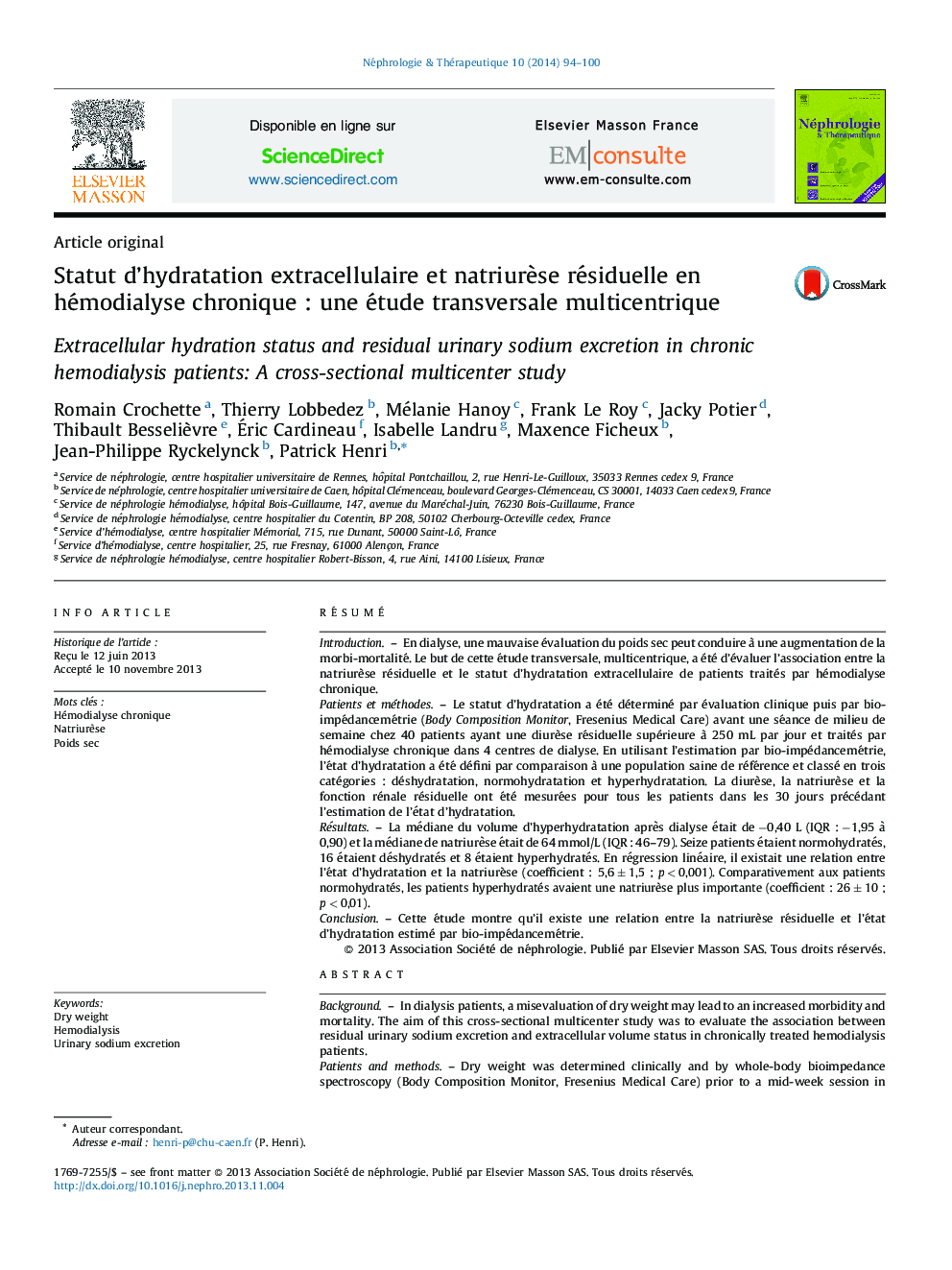| کد مقاله | کد نشریه | سال انتشار | مقاله انگلیسی | نسخه تمام متن |
|---|---|---|---|---|
| 3894532 | 1250117 | 2014 | 7 صفحه PDF | دانلود رایگان |

RésuméIntroductionEn dialyse, une mauvaise évaluation du poids sec peut conduire à une augmentation de la morbi-mortalité. Le but de cette étude transversale, multicentrique, a été d’évaluer l’association entre la natriurèse résiduelle et le statut d’hydratation extracellulaire de patients traités par hémodialyse chronique.Patients et méthodesLe statut d’hydratation a été déterminé par évaluation clinique puis par bio-impédancemétrie (Body Composition Monitor, Fresenius Medical Care) avant une séance de milieu de semaine chez 40 patients ayant une diurèse résiduelle supérieure à 250 mL par jour et traités par hémodialyse chronique dans 4 centres de dialyse. En utilisant l’estimation par bio-impédancemétrie, l’état d’hydratation a été défini par comparaison à une population saine de référence et classé en trois catégories : déshydratation, normohydratation et hyperhydratation. La diurèse, la natriurèse et la fonction rénale résiduelle ont été mesurées pour tous les patients dans les 30 jours précédant l’estimation de l’état d’hydratation.RésultatsLa médiane du volume d’hyperhydratation après dialyse était de −0,40 L (IQR : −1,95 à 0,90) et la médiane de natriurèse était de 64 mmol/L (IQR : 46–79). Seize patients étaient normohydratés, 16 étaient déshydratés et 8 étaient hyperhydratés. En régression linéaire, il existait une relation entre l’état d’hydratation et la natriurèse (coefficient : 5,6 ± 1,5 ; p < 0,001). Comparativement aux patients normohydratés, les patients hyperhydratés avaient une natriurèse plus importante (coefficient : 26 ± 10 ; p < 0,01).ConclusionCette étude montre qu’il existe une relation entre la natriurèse résiduelle et l’état d’hydratation estimé par bio-impédancemétrie.
BackgroundIn dialysis patients, a misevaluation of dry weight may lead to an increased morbidity and mortality. The aim of this cross-sectional multicenter study was to evaluate the association between residual urinary sodium excretion and extracellular volume status in chronically treated hemodialysis patients.Patients and methodsDry weight was determined clinically and by whole-body bioimpedance spectroscopy (Body Composition Monitor, Fresenius Medical Care) prior to a mid-week session in 40 chronic hemodialysis patients with significant residual diuresis (more than 250 mL per day) and receiving treatment in four dialysis centers. Regarding their hydration status assessed by the Body Composition Monitor and in comparison to a healthy reference population, patients were assigned to 1 of the 3 categories: overhydrated, normohydrated and dehydrated. Urine output, urinary sodium excretion and residual renal function were measured for all patients within 30 days before dry weight assessment.ResultsThe median post-HD session FO was of −0.40 L (IQR: from −1.95 to +0.90) and the median residual urinary sodium excretion was of 64 mmol/L (IQR: 46–79). Among these patients, 16 were normohydated, 16 were dehydrated and 8 were overhydrated. There was a linear relationship between the hydration status after HD session and the urinary sodium excretion (estimate: 5.6 ± 1.5; p < 0.001). Compared with normohydrated patients, overhydrated patients had a higher residual urinary sodium excretion (estimate: 26 ± 10; p < 0.01).ConclusionIn this study, urinary sodium excretion is associated with the hydration status evaluated by whole-body bioimpedance spectroscopy.
Journal: Néphrologie & Thérapeutique - Volume 10, Issue 2, April 2014, Pages 94–100